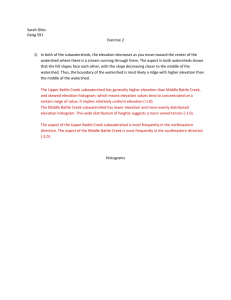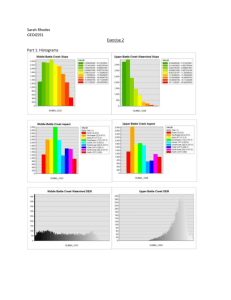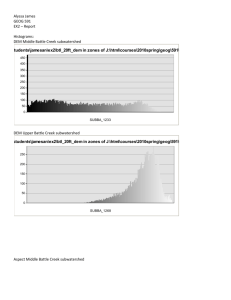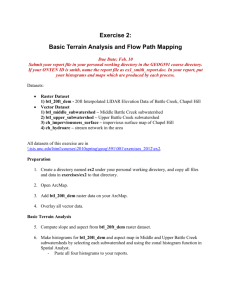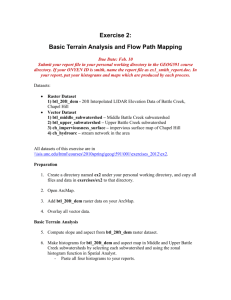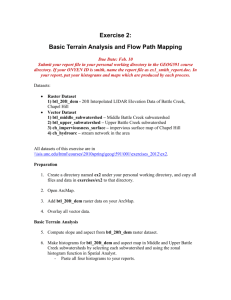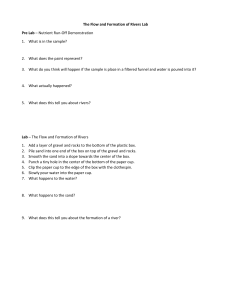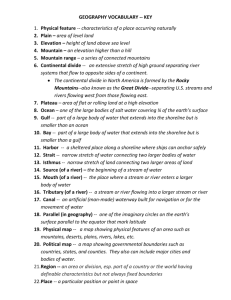ex2_qz_reporta_grade..
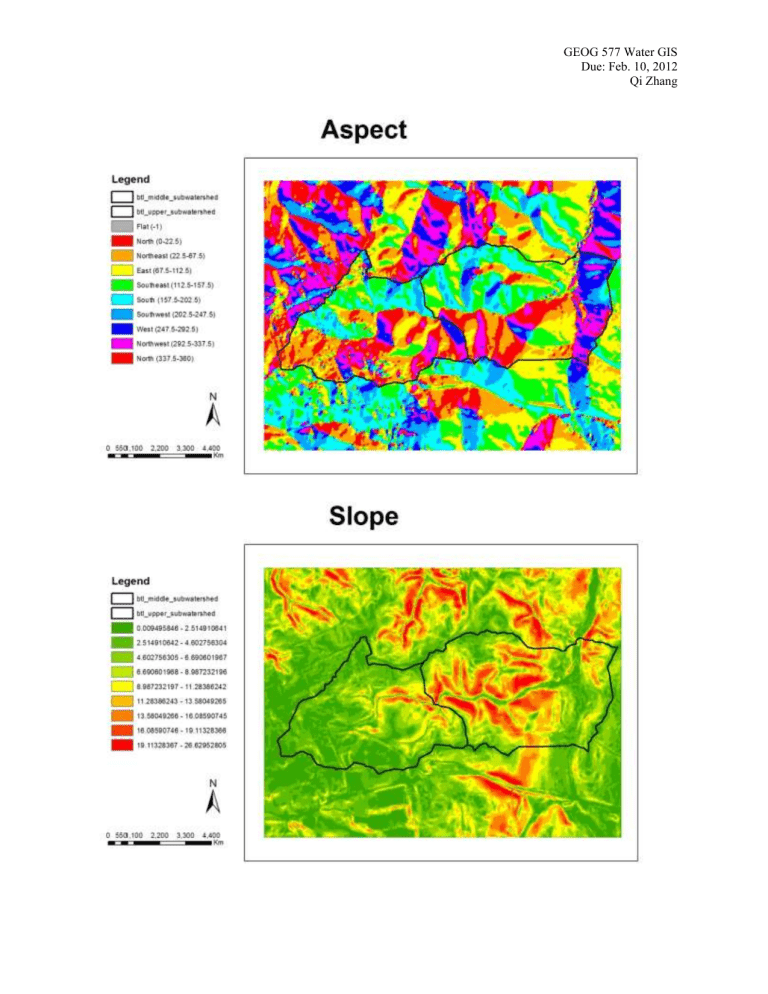
GEOG 577 Water GIS
Due: Feb. 10, 2012
Qi Zhang
GEOG 577 Water GIS
Due: Feb. 10, 2012
Qi Zhang
Q1. Differentiate between terrain characteristics in each of the subwatershed areas based on the DEM and aspect distributions. How are DEM and aspect distributed in each of the two subwatersheds? btl_20ft_dem in Middle Battle Creek subwatershed btl_20ft_dem in Upper Battle Creek subwatershed
For these two graphs relating to DEM, there is high frequency of distribution at relative low level but very small portion at high level for the first one, which indicates Middle subwatershed has mainly lower elevation. For the next, though the majority of the proportion is low elevation in this area, but there are relatively higher elevation comparing those in Middle subwatershed.
GEOG 577 Water GIS
Due: Feb. 10, 2012
Qi Zhang
Aspect map in Middle Battle Creek subwatershed
Aspect map in Upper Battle Creek subwatershed
By checking back with the Aspect map, the two distributions are quite similar for these two subwatershed except the east area of the Middle area. The higher elevation locates the east and the lower the west. This makes sense for that upper streams flow to the middle area where the area is lower.
These are the vertical graphs for each watershed in DEM and Aspect.
GEOG 577 Water GIS
Due: Feb. 10, 2012
Qi Zhang
GEOG 577 Water GIS
Due: Feb. 10, 2012
Qi Zhang
The Upper Battle Creek subwatershed has generally higher elevation than Middle Battle Creek, and skewed elevation histogram, which means elevation values tend to concentrated on a certain range of value. It implies relatively uniform elevation (-0.5).
The Middle Battle Creek subwatershed has lower elevation and more evenly distributed elevation histogram. This wide distribution of heights suggests a more varied terrain (-1.0).
The aspect of the Upper Battle Creek subwatershed is most frequently in the northeastern direction. The aspect of the Middle Battle Creek is most frequently in the southeastern direction
(-2.0).
Q2. Compare the stream network and flow direction maps between the original and filled
DEM. What is the major difference between them?
GEOG 577 Water GIS
Due: Feb. 10, 2012
Qi Zhang
By comparing the original and filled stream network, I find that the network of the filled DEM is more likely to be continuous (i.e. higher connectivity). After filling the pits, the direction of streams could be detected and the disrupted pits could be connected again.
Comparing the flow direction, it is showed that several areas have the contiguous flow direction (?
Not sure what this means..) in filled DEM. It is also the similar situation for Flow Accumulation.
The flow direction is very similar for the original and filled DEM, except where pits exist.
GEOG 577 Water GIS
Due: Feb. 10, 2012
Qi Zhang
Q3. Comment on the spatial distribution of depression cells. Where can you find major pits? How does filling pits affect the flow paths of this area? Why?
GEOG 577 Water GIS
Due: Feb. 10, 2012
Qi Zhang
The bright patches are where pits locate. Most of them are at lower elevation where water flow in. by filling the pits, it is recognizable for the direction of streams based on the assumption (what is the assumption of stream direction?).
Pit location: Around a main stream (Battle Creek) and roads (-2.0)
By filling the pits, some streams were rerouted and became more connected (-1.0).
Q4. How many hectares is the 1000 and the 500 grid cell threshold that defines the stream heads? Use “FlowAcc_fill”, “str_1000_fill” and “str_500_fill” for the comparison.
GEOG 577 Water GIS
Due: Feb. 10, 2012
Qi Zhang
Q5. What range of drainage area (in hectares) appears to define a stream head in this area?
By clicking head of the 500 stream pixel, I found the count number is 87480, also each pixel area is 20 * 20 = 400 ft
2
So, 87480 * 400 = 34992000 ft
2 then to transformed in hectare unit which is 325 hectares.
1 square foot = 0.000009290304 hectare
Here are some example of stream head area;
For stream_500, 601 *400 * 0.000009290304 hectare = 2.233 hectares.
For stream_1000, 1346 *400 * 0.000009290304 hectare = 5.002 hectares. (-4.0)
(14.5/25)
